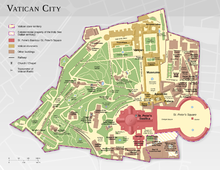Vatican City
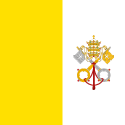
The Vatican City
60 Minutes through the holy see, Headquarters of world wide Catholic Church, Where the Pope lives, works and spreads the Gospel of true God. A complete story about the real and true church,which has above 2000 years of legacy. A Documentary about the Holy father and Bones of the St. Paul (first Apostle of Jesus).
Vatican City ![]() i/ˈvætɨkən ˈsɪti/, officially Vatican City State (Italian: Stato della Città del Vaticano; [ˈstaːto della t͡ʃitˈta del vatiˈkaːno]), is a landlockedsovereign city-state whose territory consists of a walled enclave within the city o f Rome. It has an area of approximately 44 hectares (110 acres), and a population of around 840. This makes Vatican City the smallest internationally recognized independent state in the world by both area and population.
i/ˈvætɨkən ˈsɪti/, officially Vatican City State (Italian: Stato della Città del Vaticano; [ˈstaːto della t͡ʃitˈta del vatiˈkaːno]), is a landlockedsovereign city-state whose territory consists of a walled enclave within the city o f Rome. It has an area of approximately 44 hectares (110 acres), and a population of around 840. This makes Vatican City the smallest internationally recognized independent state in the world by both area and population.
Vatican City is an ecclesiastical or sacerdotal–monarchical state, ruled by the Bishop of Rome—the Pope. The highest state functionaries are all Catholic clergymen of various national origins. It is the sovereign territory of the Holy See(Latin: Sancta Sedes) and the location of the Pope’s residence, referred to as the Apostolic Palace. The Popes have generally resided in the area that in 1929 became Vatican City since the return from Avignon in 1377, but have also at times resided in the Quirinal Palace in Rome and elsewhere.
In the city are cultural sites such as St. Peter’s Basilica, the Sistine Chapel and theVatican Museums. They feature some of the world’s most famous paintings and sculptures. The unique economy of Vatican City is supported financially by the sale of postage stamps and tourist mementos, fees for admission to museums, and the sale of publications.
The independent city-state was established in 1929 by the Lateran Treaty, signed by Cardinal Secretary of State Pietro Gasparri, on behalf of Pope Pius XI and by Prime Minister Benito Mussolini on behalf of King Victor Emmanuel III of Italy. The treaty spoke of it as a new creation (Preamble and Article III), not as a vestige of the much larger Papal States (756–1870) that had previously encompassed much of central Italy.
Vatican City State is distinct from the Holy See, which dates back to early Christianity and is the main episcopal see of 1.2 billion Latin and Eastern Catholic adherents around the globe. Ordinances of Vatican City are published in Italian; official documents of the Holy See are issued mainly in Latin. The two entities have distinct passports: the Holy See, not being a country, issues only diplomatic and service passports, whereas Vatican City State issues normal passports for its citizens.
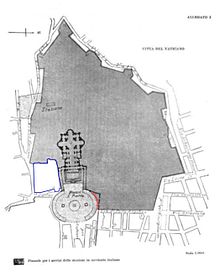 Territory of Vatican City State according to the Lateran Treaty
Territory of Vatican City State according to the Lateran Treaty
The name “Vatican” predates Christianity and comes from the Latin Mons Vaticanus, meaning Vatican Mount. The territory of Vatican City is part of the Mons Vaticanus, and of the adjacent former Vatican Fields. It is in this territory that St. Peter’s Basilica, the Apostolic Palace, the Sistine Chapel, and museums were built, along with various other buildings. The area was part of the Roman rione of Borgo until 1929. Being separated from the city, on the west bank of the Tiber river, the area was an outcrop of the city that was protected by being included within the walls of Leo IV (847–55), and later expanded by the current fortification walls, built under Paul III (1534–49), Pius IV (1559–65) and Urban VIII (1623–44).
When the Lateran Treaty of 1929 that gave the state its form was being prepared, the boundaries of the proposed territory were influenced by the fact that much of it was all but enclosed by this loop. For some tracts of the frontier, there was no wall, but the line of certain buildings supplied part of the boundary, and for a small part of the frontier a modern wall was constructed.
The territory includes St. Peter’s Square, distinguished from the territory of Italy only by a white line along the limit of the square, where it touches Piazza Pio XII. St. Peter’s Square is reached through the Via della Conciliazione which runs from close to the Tiber River to St. Peter’s. This grand approach was constructed by Benito Mussolini after the conclusion of the Lateran Treaty.
According to the Lateran Treaty, certain properties of the Holy See that are located in Italian territory, most notably the Papal Palace of Castel Gandolfo and the major basilicas, enjoy extraterritorial status similar to that of foreign embassies. These properties, scattered all over Rome and Italy, house essential offices and institutions necessary to the character and mission of the Holy See.
Castel Gandolfo and the named basilicas are patrolled internally by police agents of Vatican City State and not by Italian police. According to the Lateran Treaty (Art. 3) St. Peter’s Square, up to but not including the steps leading to the basilica, is normally patrolled by the Italian police.
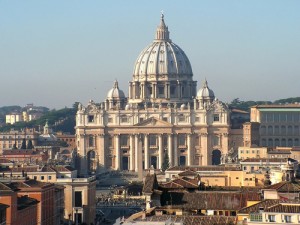 There are no passport controls for visitors entering Vatican City from the surrounding Italian territory. There is free public access to Saint Peter’s Square and Basilica and, on the occasion of papal general audiences, to the hall in which they are held. For these audiences and for major ceremonies in Saint Peter’s Basilica and Square, tickets free of charge must be obtained beforehand. The Vatican Museums, incorporating the Sistine Chapel, usually charge an entrance fee. There is no general public access to the gardens, but guided tours for small groups can be arranged to the gardens and excavations under the basilica. Other places are open only to individuals who have business to transact there.
There are no passport controls for visitors entering Vatican City from the surrounding Italian territory. There is free public access to Saint Peter’s Square and Basilica and, on the occasion of papal general audiences, to the hall in which they are held. For these audiences and for major ceremonies in Saint Peter’s Basilica and Square, tickets free of charge must be obtained beforehand. The Vatican Museums, incorporating the Sistine Chapel, usually charge an entrance fee. There is no general public access to the gardens, but guided tours for small groups can be arranged to the gardens and excavations under the basilica. Other places are open only to individuals who have business to transact there.

St. Peter’s Square, the basilica and obelisk, from Piazza Pio XII
In July 2007, the Vatican agreed to become the first carbon neutral state. They plan to accomplish this by offsetting carbon dioxide emissions with the creation of a Vatican Climate Forest in Hungary.
Within the territory of Vatican City are the Vatican Gardens (Italian: Giardini Vaticani), which account for more than half of this territory. The gardens, established during the Renaissance and Baroque era, are decorated with fountains and sculptures.
The gardens cover approximately 23 hectares (57 acres) which is most of the Vatican Hill. The highest point is 60 metres (200 ft) above mean sea level. Stone walls bound the area in the North, South and West.
The gardens date back to medieval times when orchards and vineyards extended to the north of the Papal Apostolic Palace. In 1279 Pope Nicholas III (Giovanni Gaetano Orsini, 1277–1280) moved his residence back to the Vatican from the Lateran Palace and enclosed this area with walls. He planted an orchard (pomerium), a lawn (pratellum) and a garden (viridarium).

A panorama of the gardens from atop St. Peter’s Basilica
Early History of Vatican Hill
The name “Vatican” was already in use in the time of the Roman Republic for a marshy area on the west bank of the Tiber across from the city of Rome. Under theRoman Empire, many villas were constructed there, after Agrippina the Elder (14 BC – 18 October AD 33) drained the area and laid out her gardens in the early 1st century AD. In AD 40, her son, Emperor Caligula (31 August AD 12–24 January AD 41; r. 37–41) built in her gardens a circus for charioteers (AD 40) that was later completed by Nero, the Circus Gaii et Neronis, usually called, simply, the Circus of Nero.
Even before the arrival of Christianity, it is supposed that this originally uninhabited part of Rome (the ager vaticanus) had long been considered sacred, or at least not available for habitation. A shrine dedicated to the Phrygian goddess Cybele and her consort Attis remained active long after the Constantinian Basilica of St. Peter was built nearby.
The particularly low quality of Vatican wine, even after the reclamation of the area, was commented on by the poet Martial (40 – between 102 and 104 AD). In AD 69, the Year of the Four Emperors, when the northern army that brought Aulus Vitellius to power arrived in Rome, “a large proportion camped in the unhealthy districts of the Vatican, which resulted in many deaths among the common soldiery; and the Tiber being close by, the inability of the Gauls and Germans to bear the heat and the consequent greed with which they drank from the stream weakened their bodies, which were already an easy prey to disease.”
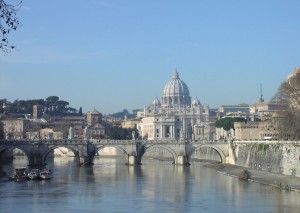 The Vatican Obelisk was originally taken by Caligula from Heliopolis, Egypt to decorate the spinaof his circus and is thus its last visible remnant. This area became the site of martyrdom of many Christians after the Great Fire of Rome in AD 64. Ancient tradition holds that it was in this circus that Saint Peter was crucified upside-down.
The Vatican Obelisk was originally taken by Caligula from Heliopolis, Egypt to decorate the spinaof his circus and is thus its last visible remnant. This area became the site of martyrdom of many Christians after the Great Fire of Rome in AD 64. Ancient tradition holds that it was in this circus that Saint Peter was crucified upside-down.
Opposite the circus was a cemetery separated by the Via Cornelia. Funeral monuments and mausoleums and small tombs as well as altars to pagan gods of all kinds of polytheistic religions were constructed lasting until before the construction of the Constantinian Basilica of St. Peter’s in the first half of the 4th century. Remains of this ancient necropolis were brought to light sporadically during renovations by various popes throughout the centuries increasing in frequency during the Renaissance until it was systematically excavated by orders of Pope Pius XII from 1939 to 1941. The Constantinian basilica was built in 326 over what was believed to be the tomb of Saint Peter, buried in that cemetery.
From then on, the area became more populated in connection with activity at the basilica. A palace was constructed nearby as early as the 5th century during the pontificate of Pope Symmachus (reigned 498–514).
Papal States – History of the Papacy
In 592, two years after his election, Pope Gregory I accepted the role of the Bishop of Rome as a temporal ruler of the city of Rome. Gregory used monastic establishments to spread the church’s spiritual rule throughout Europe.
Popes in their secular role gradually came to govern neighbouring regions and, through the Roman States, ruled a large portion of the Italian peninsula for more than a thousand years until the mid 19th century, when all of the territory belonging to the Papacy was seized by the newly created Kingdom of Italy. For much of this time the Vatican was not the habitual residence of the Popes, but rather the Lateran Palace, and in recent centuries, the Quirinal Palace, while the residence from 1309–77 was at Avignon in France.
Italian Unification – Roman Question
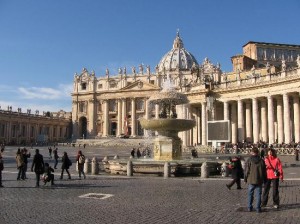 In 1870, the Pope’s holdings were left in an uncertain situation when Rome itself was annexed by the Piedmont-led forces which had united the rest of Italy, after a nominal resistance by the papal forces. Between 1861 and 1929 the status of the Pope was referred to as the “Roman Question”.
In 1870, the Pope’s holdings were left in an uncertain situation when Rome itself was annexed by the Piedmont-led forces which had united the rest of Italy, after a nominal resistance by the papal forces. Between 1861 and 1929 the status of the Pope was referred to as the “Roman Question”.
Italy made no attempt to interfere with the Holy See within the Vatican walls. However, they confiscated church property in many places. In 1871, the Palazzo Quirinale, for centuries the Papal palace, was confiscated by the king of Italy and became the royal palace. Thereafter the popes resided undisturbed within the Vatican walls, and certain papal prerogatives were recognized by the Law of Guarantees, including the right to send and receive ambassadors. But the Popes did not recognise the Italian king’s right to rule in Rome, and they refused to leave the Vatican compound until the dispute was resolved in 1929; Pope Pius IX (1846–78), the last ruler of the Papal States, claimed that after Rome was annexed he was a “Prisoner in the Vatican”. Forced to give up secular power, the popes focused on spiritual issues.
This situation was resolved on 11 February 1929, when the Lateran Treaty between the Holy See and the Kingdom of Italy was signed by Prime Minister and Head of Government Benito Mussolini on behalf of King Victor Emmanuel III and by Cardinal Secretary of State Pietro Gasparri for Pope Pius XI. The treaty, which became effective on 7 June 1929, established the independent state of Vatican City and reaffirmed the special status of Catholicism in Italy.
Vatican City during World War II
The Holy See, which ruled Vatican City, pursued a policy of neutrality during World War II, under the leadership of Pope Pius XII. Although Germany occupied the city of Rome from 1943 and the Allies from 1944, they respected Vatican City as neutral territory. One of the main diplomatic priorities of the bishop of Rome was to prevent the bombing of the city; so sensitive was the pontiff that he protested even the British air dropping of pamphlets over Rome, claiming that the few landing within the city-state violated the Vatican’s neutrality. The British policy, as expressed in the minutes of a Cabinet meeting was: “that we should on no account molest the Vatican City, but that our action as regards the rest of Rome would depend upon how far the Italian government observed the rules of war.”
After the American entry into the war, the US opposed such a bombing, fearful of offending Catholic members of its military forces, but said that “they could not stop the British from bombing Rome if the British so decided”. The British uncompromisingly said “they would bomb Rome whenever the needs of the war demanded.” In December 1942, the British envoy suggested to the Holy See that Rome be declared an “open city,” a suggestion that the Holy See took more seriously than was probably meant by the British, who did not want Rome to be an open city, but Mussolini rejected the suggestion when the Holy See put it to him. In connection with the Allied invasion of Sicily, 500 American aircraft bombed Rome on 19 July 1943, aiming particularly at the railway hub. Some 1,500 people were killed, and Pius XII himself, who had been described in the previous month as “worried sick” about the possible bombing, went to the scene of the tragedy. Another raid took placed on 13 August 1943, after Mussolini had been ousted from power. On the following day the new government declared Rome an open city, after consulting the Holy See on the wording of the declaration, but the British had decided that they would never recognize Rome as an open city.
1980’s – present
In 1984, a new concordat between the Holy See and Italy modified certain provisions of the earlier treaty, including the position of Catholicism as the Italian state religion, a position given to it by a statute of 1848.
Construction in 1995 of a new guest house, Domus Sanctae Marthae, adjacent to St Peter’s Basilica was criticised by Italian environmental groups, backed by Italian politicians. They claimed the new building would block views of the Basilica from nearby Italian apartments. For a short while the plans strained the relations between the Vatican and the Italian government. The head of the Vatican’s Department of Technical Services robustly rejected challenges to the Vatican State’s right to build within its borders.


